Theme Parks & Themed Entertainment
A Mouseketrips Mouseke-tip: How to make eating out at Disney World NOT take a bite out of your wallet
Disney travel expert Scott Liljenquist returns with some tips about how you cut food costs during your next WDW vacation.

I remember sack lunches. You know, those meals lovingly packed by Mom each day before you headed off to school. The ones that contained, by the time you got around to opening the tattered brown bag, a completely flattened PB&J, a baggie of what were once full-sized potato chips, a well-bruised apple, and some warm carrot sticks. A whole day's nutrition neatly contained in one flexible, squishable, and throwable portable container. How many of you are alive today because of sack lunches?
Unfortunately, too many folks seem to think that their Walt Disney World trip must, due to budgetary constraints and the stratospheric food prices charged at the parks, include some form of sack-lunch-type cuisine. The Disney theme parks do have a (well-earned) reputation of supplying hideously overpriced food and beverage services. It's still possible, however, to enjoy plenty of very good food at reasonable prices while on your Disney vacation by using a few tips and tricks discovered by Disney park veterans over the years. Maybe you could even eliminate the sack lunch from your repertoire once and for all.
Saving money on food during your Walt Disney World vacation really isn't all that difficult, it just requires a little bit of advance planning and a slightly different way of thinking. Here are a few of the best tips that we've compiled over the years for making the most of your food budget while you're visiting the House of Mouse.
- Stock up on small grocery items.. When you arrive in Orlando, make a grocery stop between the airport and your hotel. If you're not renting a car, most town car transfer services will include a complimentary grocery stop on the way to your hotel – make sure to ask your driver. Stock up on snacks, sodas, bottled water, and breakfast items. Buy some paper cereal bowls, small paper plates, and plastic utensils. Purchase some milk and/or juices if you know your hotel room will have a refrigerator. (By the way, Disney announced yesterday that they will be equipping all of the rooms in their Deluxe and Moderate category resorts with refrigerators at no extra charge. The Value category resort rooms can still be equipped with a refrigerator upon request, but there will be an extra charge.)
- Eat breakfast in your room. Eat a quick breakfast of bagels, cereal, fruit or other simple items in your room. Use the complimentary in-room coffee maker for making coffee, but keep in mind that it can also produce hot water for hot chocolate, tea, and even for preparing instant oatmeal. Everyone is excited to get to the parks anyway, and a fast breakfast only speeds the process.
- Carry a fanny pack/backpack. This can be a real money-saver. Take some of the items you purchased at the grocery store into the park with you. Bottled water from the grocery store is under $5 for a six-pack. Bottled water purchased in the parks is $2.50 per bottle. Another handy tip – if you have a freezer in your hotel room freeze a bottle of water the night before. Then put the frozen bottle in your fanny pack to keep other items cool. You'll also have a cool drink for most of the day as the ice melts in the bottle. Carry some granola bars, fruit snacks, and crackers to keep the kids happy in between meals.
- Split entrees. Disney's portions are usually huge. Most of the time you'll find that there's enough food in one portion to split between two people. This is a very common request at Disney restaurants, and most table service restaurants will even split the entrée for you in the kitchen and present it on two plates. This works really well if you're traveling with kids who are too tired, picky, or excited to eat very much.
- Skip the entrée altogether. Another option lots of folks, myself included, really enjoy is to order an appetizer or two and dessert, and just skip the entrée altogether. Most appetizers are large enough to count as a meal, but still small enough that you're not too stuffed to sample the dessert tray!
- Order a kids' meal. Don't hesitate or be embarrassed to order the kids' meal at Disney counter service restaurants, even if you're not quite a kid anymore. Many people find the portions offered in the kids' meals to be just the right size, and the cost is significantly lower than the adult menu prices. Do keep in mind that this only works at counter-service eateries, you can't order from the kids' menu at table service restaurants.
- Meal Vouchers. There are several different types of meal vouchers available:
o Animal Kingdom "Meals Plus". The Meals Plus program, available only at the Disney's Animal Kingdom, provides a coupon which can be used for a counter service meal with a small drink, a coupon for a box of popcorn or an ice cream, and a coupon for a bottle of water. These vouchers sell for $11.99 adult and $5.99 child, which is a significant savings over the regular price of these items if purchased separately.
o Quick & Casual Meal Vouchers. "Quick and Casual" meal vouchers can be purchased from many ticket brokers and wholesalers. They are priced at $17.50 each and can be used for lunch or dinner at most counter service and some table service restaurants. These vouchers have to be used carefully in order to realize a big savings – you have to order the priciest items in order to come out ahead.
o Character Breakfast Vouchers. Also available from ticket brokers and wholesalers are Character Breakfast vouchers which can be used for any of the Character Breakfast meals offered throughout the resort. These vouchers don't really end up saving anything, and in my opinion are more trouble than they're worth.
- Alter your eating schedule. I've saved this tip for last, because I've found it to be the best and easiest method for saving money on food during my Walt Disney World trips. Most folks eat breakfast early in the morning, followed by a lunch around midday, with dinner being the "big" meal of the day sometime around 6:00 pm or so. If you just alter your food schedule and priority a little bit, it can end up saving you a lot. Let me explain what I mean.
For breakfast, my family will either eat in the room using the food we bought at the grocery store, or, if we're eating at a restaurant for breakfast, we schedule a very late Priority Seating. Sometime after 10:00 a.m. is best, which makes Priority Seatings very easy to get. We can catch an hour or so in the parks as soon as they open and enjoy the shorter lines, and then head to breakfast just as everyone else is arriving. After breakfast we return to the parks and use the snacks and water we brought with us to hold us over until late afternoon.
We eat our "big" meal of the day at around 4:00 p.m. – as late as we can before the restaurant changes from the lunch to the dinner menu. Lunch prices are always significantly lower than dinner prices, and most of the entrees served from the lunch menu are the same size or just slightly smaller than those served from the dinner menu. As an added bonus, we enjoy the shorter attraction lines in the parks while everyone else is trying to find a place to eat lunch during the "normal" lunch hours. It's also lots easier to get a table at the more popular restaurants later in the afternoon.
For dinner, which is a much lighter meal than lunch, we wait until late in the evening. If our trip is during the off-season when the parks close early, we'll wait until leaving the park and perhaps drive off-site somewhere for a less-expensive meal, or get quick service food at our hotel. If we're in the parks until later, we'll find a snack at an outdoor vending cart or a quick bite at a counter service restaurant.
Well, there you have it. While this is certainly not a comprehensive list of money-saving ideas for your Walt Disney World meal budget, it does contain the most effective ideas we've found so far. We're always learning new tips and tricks, and would love to hear any ideas you might have that we have not covered. Our readers, friends, and clients are our very best source of information, and we love finding new and unique ways to stretch vacation dollars and enhance the fun of a Disney vacation.
So fold up the brown bags, put away the Thermos, and close the box of sandwich baggies. Leave your sack lunches home – you're going to Disney World!
Scott Liljenquist is co-owner of Mouseketrips.com, the web's best Disney-only travel agency. A graduate of the College of Disney Knowledge, he suffers from a serious Disney Obsession Disorder. Unhappy unless he's either on a WDW vacation or planning the next one, he can usually be found scouring the 'net for the latest Disney news, rumors, and gossip. For further information on the sorts of trips and tours that Mouseketrips offers, visit the Mouseketrips web site.
Television & Shows
The Untold Story of Super Soap Weekend at Disney-MGM Studios: How Daytime TV Took Over the Parks
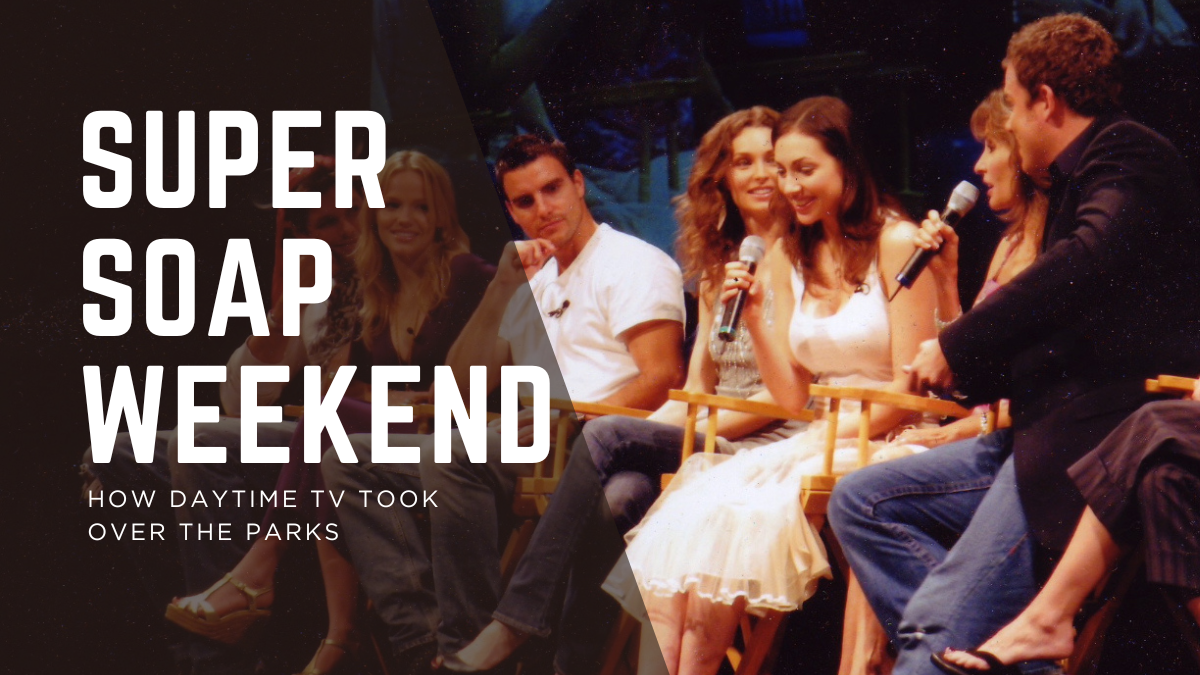
A long time ago in a galaxy that … Well, to be honest, wasn’t all that far away. This was down in Florida after all. But if you traveled to the WDW Resort, you could then experience “Star Wars Weekends.” Which ran seasonally at Disney’s Hollywood Studios Disney World from 1997 to 2015.
Mind you, what most folks don’t remember is the annual event that effectively plowed the road for “Star Wars Weekends.” Which was “Super Soap Weekend.” That seasonal offering — which allowed ABC soap fans to get up-close with their favorite performers from “All My Children,” “General Hospital,” “One Life to Live” and “Port Charles” — debuted at that same theme park the year previous (1996).
So how did this weekend-long celebration of daytime drama (which drew tens of thousands of people to Orlando every Fall for 15 years straight) come to be?
Michael Eisner’s Daytime TV Origins and a Theme Park Vision
Super Soap Weekend was the brainchild of then-Disney CEO Michael Eisner. His career in media began with short stints at NBC and CBS, but it truly took off in 1964 when he joined ABC as the assistant to Leonard Goldberg, who was the network’s national programming director at the time.
Eisner quickly advanced through the ranks. By 1971, he had become Vice President of Daytime Programming at ABC. That meant he was on the scene when One Life to Live joined the lineup in July 1968 and when All My Children made its debut in January 1970. Even after being promoted to Senior Vice President of Prime Time Programming in 1976, Eisner stayed close to the daytime division and often recruited standout soap talent for ABC’s primetime shows.
Fast forward nearly two decades to July 31, 1995. The Walt Disney Company announced that it would acquire ABC/Cap Cities in a $19 billion deal. Although the acquisition wasn’t finalized until February 1996, Eisner was already thinking ahead. He wanted to use the stars of All My Children, One Life to Live, and General Hospital to draw people to Disney’s theme parks.
He had seen how individual soap stars were drawing huge mall crowds across America since the late 1970s. Now he wanted to bring dozens of them together for something much bigger.
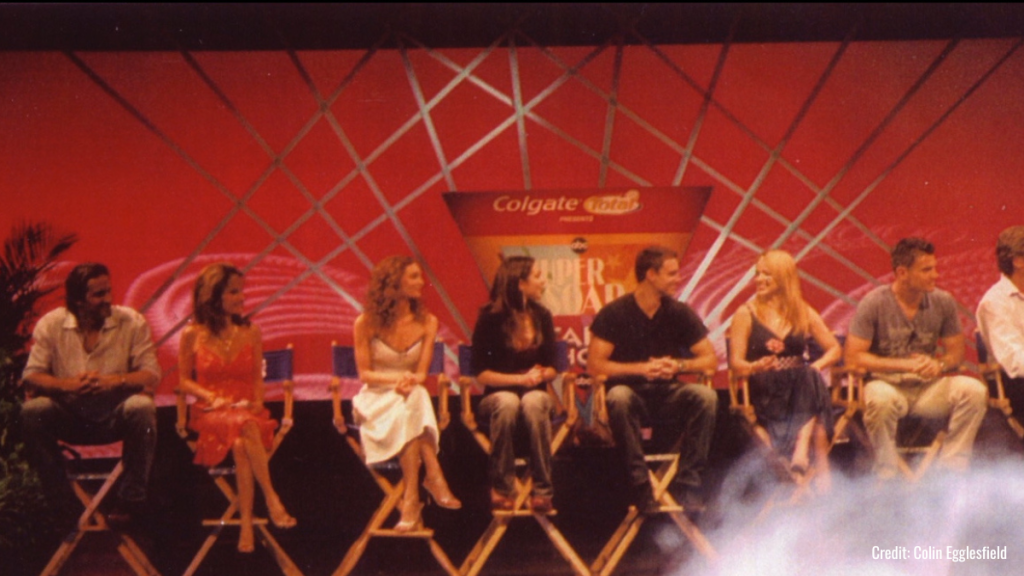
Super Soap Weekend Takes Over Disney-MGM Studios
The very first Super Soap Weekend was announced in June 1996, just a few months after the ABC deal closed. The event was scheduled for October 19 and 20 at Disney-MGM Studios and was a massive success.
The weekend featured panel discussions, autograph sessions, and photo opportunities with the stars of ABC’s daytime dramas. Thousands of fans packed the park for the chance to meet their favorite actors. Due to the overwhelming response, the event became an annual tradition and was eventually moved to Veterans Day weekend each November to better accommodate attendees.
Longtime fans like Nancy Stadler, her mom Mary, and their close friend Angela Ragno returned year after year, making the event a personal tradition and building lifelong memories.
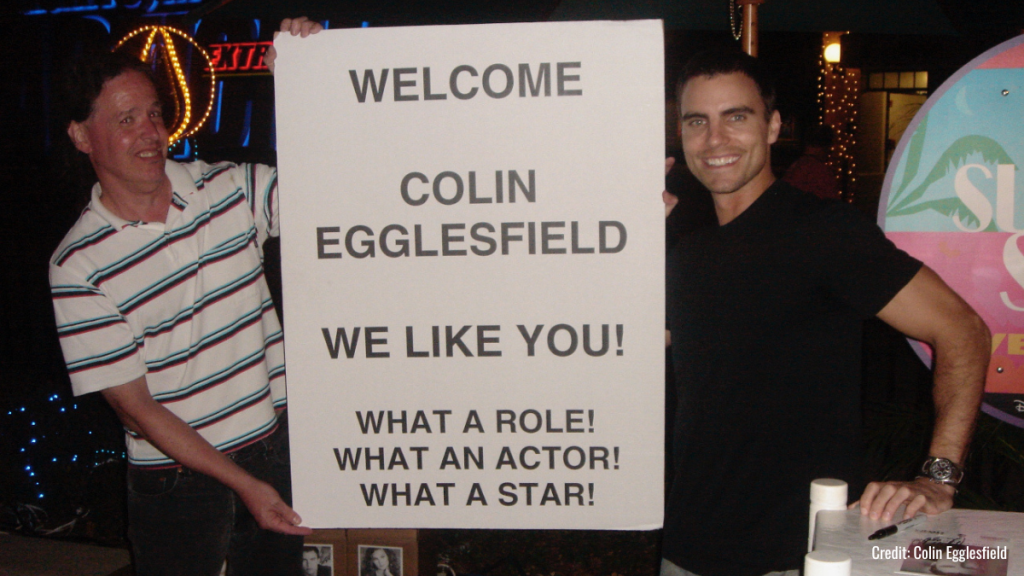


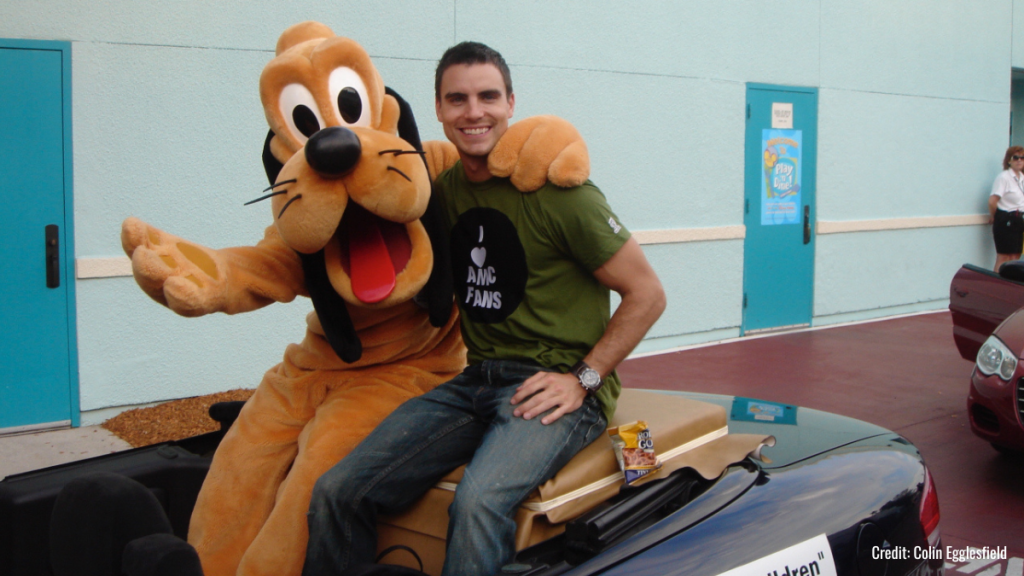
West Coast Events and the ABC Soap Opera Bistro
Disney even tried to recreate the event out west. Two Super Soap Weekends were held at Disneyland Resort, one in April 2002 and another in June 2003.
At Disney’s California Adventure, Eisner also introduced the ABC Soap Opera Bistro, a themed dining experience that opened in February 2001. Guests could dine inside recreated sets from shows like General Hospital and All My Children, including Kelly’s Diner and the Chandler Mansion. The Bistro closed in November 2002, but for fans, it offered a rare opportunity to step into the world of their favorite soaps.
SOAPnet, Port Charles, and the Expansion of Daytime TV at Disney
Eisner’s enthusiasm for soaps extended beyond the parks. In January 2000, he launched SOAPnet, a cable channel dedicated to prime time replays of ABC’s daytime dramas.
During his time at Disney, General Hospital also received a spin-off series titled Port Charles, which aired from June 1997 to October 2003. The show leaned into supernatural plotlines and was another example of Eisner’s commitment to evolving and expanding the soap genre.
The Final Curtain for Super Soap Weekend
In September 2005, Eisner stepped down after 21 years as head of The Walt Disney Company. Bob Iger, who had previously served as President of ABC and Chief Operating Officer of ABC/Cap Cities, took over as CEO. While Iger had deep ABC credentials, he didn’t share Eisner’s passion for daytime television.
In the fall of 2008, Disney hosted the final Super Soap Weekend at what was then still called Disney-MGM Studios. That same year, the park was rebranded as Disney’s Hollywood Studios, and Disney began shifting away from television-focused experiences.
Within the next five years, the rest of Eisner’s soap legacy faded. One Life to Live was canceled in January 2012. SOAPnet was rebranded as Disney Junior in February 2013. Later that year, All My Children ended its 41-year run on ABC.
Only General Hospital remains on the network today, the last standing soap from the golden age of ABC Daytime.
A New Chapter for Daytime TV and Super Soap Fans
The soap genre may have faded from its former glory, but it’s not gone. On February 24, 2025, CBS premiered a brand-new daytime drama called Beyond the Gates, marking the first new soap launch in years.
Meanwhile, All My Children alum Kelly Ripa has been actively working on a revival. In September 2024, she mentioned a holiday-themed movie set in Pine Valley that would bring back many original cast members. The project was in development for Lifetime, though its current status is unclear.
And what about Super Soap? Fans like Nancy and Angela still hope Disney will bring it back. Even if it only featured the cast of General Hospital, it would be a welcome return for longtime viewers who miss that one weekend a year where the magic of Disney collided with the drama of daytime TV.
If you want to hear firsthand what it was like to be part of Super Soap Weekend, be sure to listen to our I Want That Too podcast interview with actor Colin Egglesfield. He shares behind-the-scenes memories from his days as Josh Madden on All My Children and what it meant to be part of one of the most unique fan events in Disney park history.
History
The Super Bowl & Disney: The Untold Story Behind ‘I’m Going to Disneyland!’

One of the highlights of the Super Bowl isn’t just the game itself—it’s the moment when the winning quarterback turns to the camera and exclaims, “I’m going to Disney World!” This now-iconic phrase has been a staple of post-game celebrations for decades. But where did this tradition begin? Surprisingly, it didn’t originate in a stadium but at a dinner table in 1987, in a conversation involving Michael Eisner, George Lucas, and aviation pioneers Dick Rutan and Jeana Yeager.

The Unlikely Beginning of a Marketing Sensation
To understand the origins of this campaign, we have to go back to December 1986, when the Rutan Voyager became the first aircraft to fly around the world without stopping or refueling. Pilots Dick Rutan and Jeana Yeager completed the nine-day journey on December 23, 1986, flying over 26,000 miles before landing at Edwards Air Force Base. Their historic achievement earned them national recognition, and just days later, President Ronald Reagan awarded them the Presidential Citizen Medal at the White House.
Meanwhile, Disney was gearing up for the grand opening of Star Tours at Disneyland, set for January 12, 1987. Following its usual playbook of associating major theme park attractions with real-world pioneers, Disney’s PR team invited astronauts Gordon Cooper and Deke Slayton to the launch event. But in a twist, they also invited Rutan and Yeager, who were still making headlines.
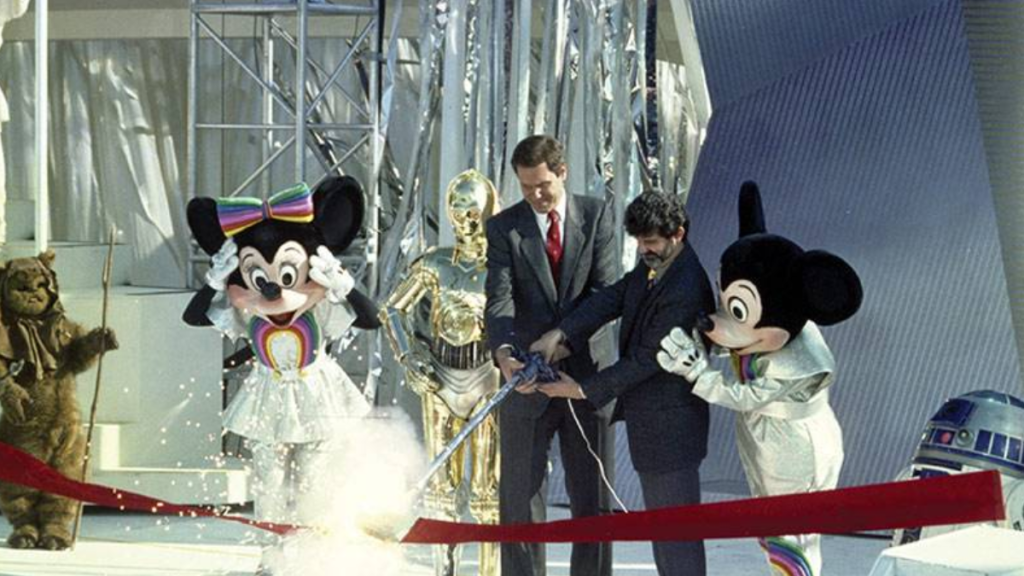
A Dinner Conversation That Changed Advertising Forever
After the Star Tours opening ceremony, a private dinner was held with Disney CEO Michael Eisner, George Lucas, and Eisner’s wife, Jane. During the meal, Eisner asked Rutan and Yeager, “You just made history. You traveled non-stop around the planet on a plane without ever refueling. How are you ever going to top that, career-wise? What are you two gonna do next?”
Without hesitation, Jeana Yeager replied, “Well, after being cramped inside that tiny plane for nine days, I’m just glad to be anywhere else. And even though you folks were nice enough to fly us here, invite us to your party… Well, as soon as we finish eating, I’m gonna go over to the Park and ride some rides. I’m going to Disneyland.”
Jane Eisner immediately recognized the power of Yeager’s statement. On the car ride home, she turned to Michael and said, “That’s a great slogan. I think you should use that to promote the theme parks.” Like many husbands, Michael initially dismissed the idea, but Jane persisted. Eventually, Eisner relented and pitched it to his team.
The Super Bowl Connection
With Super Bowl XXI just around the corner, Disney’s PR team saw an opportunity. The game was set for January 25, 1987, at the Rose Bowl in Pasadena—just miles from Disney Studios. What if they convinced the winning quarterback to say, “I’m going to Disneyland” live on-air?
Disney quickly struck a deal with both quarterbacks—Phil Simms of the New York Giants and John Elway of the Denver Broncos—offering each $75,000 to deliver the line if their team won. Simms led the Giants to victory, making history as the first athlete to say, “I’m going to Disney World!” on national television.
A Marketing Triumph
That year’s Super Bowl had the second-highest viewership in television history, with 87 million people watching Simms say the famous line. The next day, Disney turned the clip into a national commercial, cementing the phrase as a marketing goldmine.
Since then, “I’m going to Disneyland” (or Disney World, depending on the commercial) has been a staple of championship celebrations, spanning the NFL, NBA, and even the Olympics. What started as a casual remark at dinner became one of the most successful advertising campaigns in history.
A Lasting Legacy
Jane Eisner’s keen instinct and Disney’s ability to act quickly on a great idea created a tradition that continues to captivate audiences. The “I’m going to Disneyland” campaign remains a testament to the power of spontaneous inspiration and smart marketing, proving that sometimes, the best ideas come from the most unexpected places.
To learn more about Disney’s ties to the world of sports, check out I Want That Too: A Disney History and Consumer Product Podcast.
Television & Shows
How the Creators of South Park Tricked A-List Celebrities to Roast Universal – “Your Studio & You”
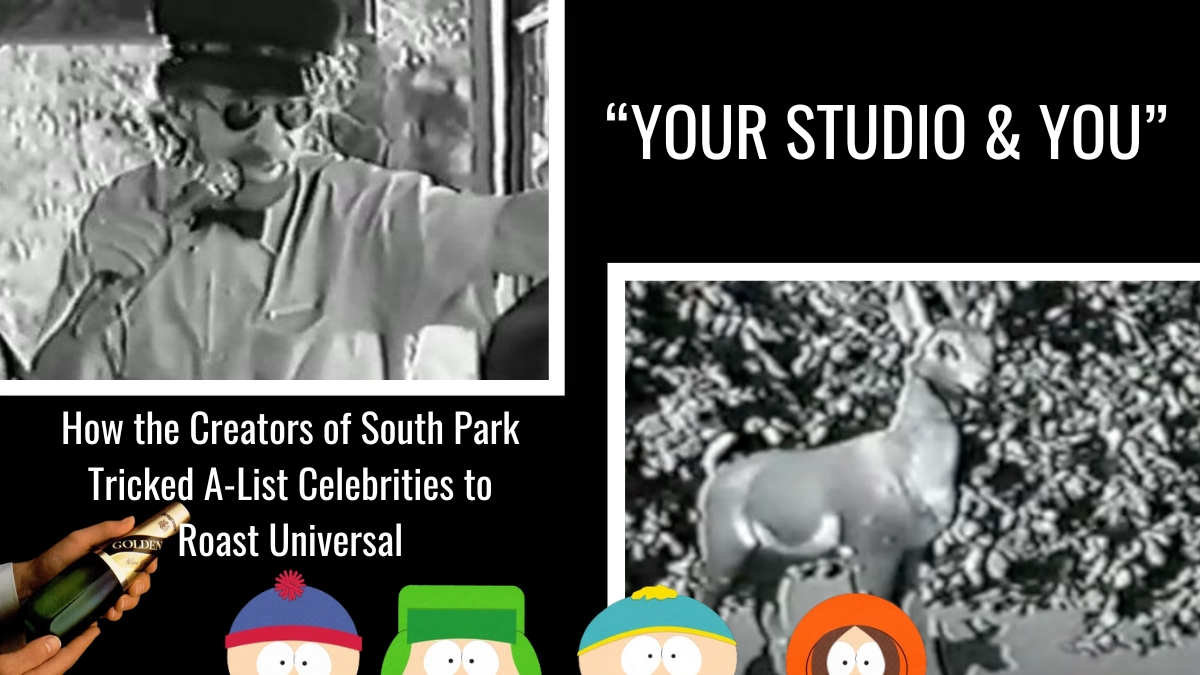
Universal Studios has a rich and storied history, but few moments are as peculiar—and as hilariously cutting—as the creation of Your Studio & You. This 14-minute parody film, commissioned in 1995 to celebrate Universal’s new ownership under Seagram’s, brings together an all-star cast, biting humor, and the unmistakable comedic fingerprints of Matt Stone and Trey Parker.
Long before South Park debuted on Comedy Central in 1997, Stone and Parker were already carving out a reputation for their irreverent style, and Your Studio & You perfectly encapsulates their knack for turning even the most corporate project into something delightfully subversive.
Matt Stone & Trey Parker Before South Park
Stone & Parker were already known out in Hollywood as funny guys. Thanks largely to “The Spirit of Christmas,” which was this video greeting card that they’d crafted for a Fox executive – who then distributed this infamously funny thing (which had Our Lord Jesus Christ & Santa Claus literally duking it out for the holiday affections of Cartman, Kenny, Stan & Kyle) to friends & family.
This was the early 1990s. No internet. Each copy of “The Spirit of Christmas” was made on VHS tape and then mailed. Went viral the old-fashioned way. It’s rumored that George Clooney made over 300 copies of “The Spirit of Christmas” and passed these VHS taps along to friends and family.
Things didn’t move as fast as they do today. “The Spirit of Christmas” still became a sensation out West.
Zucker Brothers
Matt & Trey also had other supporters in the entertainment industry. Among them David Zucker, who was one of the members of ZAZ (i.e., Zucker Abrahams Zucker), the talented trio that made “Airplane!” in 1980, “Top Secret!” in 1984 and the three “Naked Gun” movies.
- The original “Naked Gun” in 1988
- “Naked Gun 2 & 1/2 : The Smell of Fear” in 1991
- and “Naked Gun 33 & a 1/3: The Final Insult” in 1994
All five of these parody films had been made for Paramount Pictures. But in the Late Winter / Early Spring of 1995, Universal had persuaded the Zucker Brothers to come over and set up shop in a bungalow on their lower lot. With the hope that – at some point further on down the line – David & his brother Jerry would start making funny films for Universal.

And it’s during this same window of time (We’re now talking April of 1995) that news breaks that Seagrams (Yep, the adult beverage company. Who – at the time – was making an absolute fortune on the sales of wine coolers) was about to buy a majority stake in MCAUniversal. We’re talking control of 80% of that company’s stock. Which would effectively make Seagrams the new owners of Universal Studios.
Edgar Bronfman
And Edgar Bronfman – the owner of Seagrams – knew that Universal had had a tough time with its previous owners – which had been the Matsushita Electric Industrial Co. of Japan. Matsushita had bought MCA back in November of 1990 for $7.5 billion but had never really understood the entertainment industry.
This is why – after repeatedly butting heads with Lew Wasserman & Sidney Sheinberg (i.e., the heads of Universal Studios & the Universal theme park respectively) when it came to creative control of this company – Matsushita decided to wash it hands of the entire enterprise. Agreeing to sell their holdings in MCA to Seagrams for $5.7 billion (effectively taking a nearly $2 billion loss on this investment).
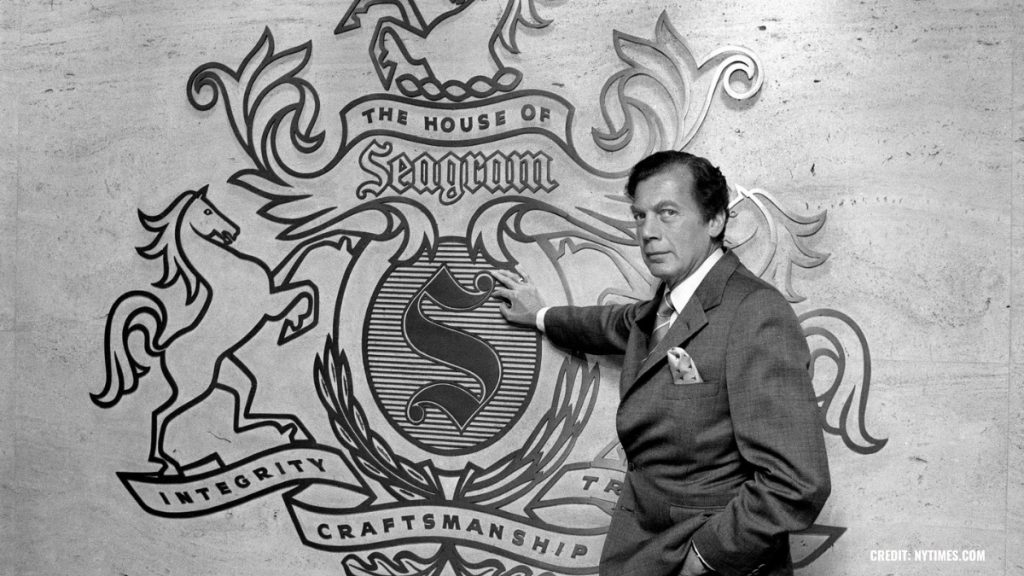
And Bronfman … He knew that some bad feeling had developed between Hollywood’s creative community and the Japanese owners of Universal. The thinking was that executives at Matsushita Electric had just not gotten what it took to make movies & TV shows.
And Edgar? Right from the get-go, he wanted to show that Seagrams was NOT going to be Matsushita Electric Redux. Bronfman was looking for a way to send a clear message to Hollywood’s creative community that Universal’s new owners got it. That they were willing to work with Hollywood to make the best possible movies & TV shows at Universal.
And how did Edgar decide to get this message across? By making a funny movie.
Zucker Commissions Trey Parker for “Your Studio & You”
Mind you, Bronfman himself didn’t make this film. The owner of Seagrams reached out to David Zucker. Who – after initially agreeing to produce this introduction-to-Universal film – then farmed out the production of the actual project to Trey Parker. Who – just two days before shooting was supposed to star on the Universal Lot – persuaded Matt Stone to come help him on this project.
Which brings us to “Your Studio and You.” Which is a parody of an educational film from the 1950s, right down to being shot in black & white and featuring a very generic soundtrack.
Now what’s amazing about watching “Your Studio and You” today is that this 14-minute-long film features some of the biggest names working in Hollywood back in the mid-1990s. We’re talking about people like recent Golden Globe winner Demi Moore, Sylvester Stallone, Michael J. Fox and Angela Lansbury. Not to mention two of the most powerful men in all of Hollywood, Steven Spielberg & Jeffrey Katzenberg.
And what’s especially interesting about watch “Your Studio and You” is that – as you watch these performers go through their paces in this motion pictures (which – most of the time – involves doing some innocuous task while holding a Seagram’s wine cooler) – you often get the feeling that this star is not in on the gag.
So how did Matt & Trey get away with this? Simple. There was never actually a script for “Your Studio and You.”
Filming “Your Studio & You” at Universal Studios Hollywood
Mind you, David Zucker would always insist that there was. Especially when he’d phone up celebrities on the Universal Lot and say “Hey, I’m sending over a couple of college kids later today. They’re working with me on a new parody film. It’s something that we’re doing for the new owners of Universal. I need just a half hour of your time. We’re shooting something special for the party we’ll be holding when the Seagrams people first arrive at the Studio. Absolutely. You’ll definitely get an invite to that party. So can I count on you to help these kids out? Beautiful. They’ll be over there later this morning.”
And then Matt & Trey would show up and say “… Dang, Miss Lansbury. We’re sorry. We must have left our copy of the ‘Your Studio and You’ script back in our office. Which is clear on the other side of the Lot. So – rather than waste your time – why don’t we do this instead? Follow us over to the Psycho House. Where we’re then going to get footage of you painting the front porch on Mother Bates’ house while you say ‘Gosh, with all of the wonderful improvements going on around here, everyone is going to want to work at Universal.’ Oh, and can we also get you to wear this button on the front of your blazer which reads ‘Universal is A-OK’ ? “

And over & over again, the biggest names who were working for Universal at that time took part in the production of “Your Studio & You” because A) David Zucker vouched for Matt Stone & Trey Parker and B) this was something that was being made for the new owners of Universal. And it’s just natural to want to get in good with the new boss.
Steven Spielberg, Jeffery Katzenberg, and Jaws
But no one at Universal anticipated that “Your Studio & You” would wind up being as sharp edged as the finished product turned out to be. I mean, it’s one thing to bite the hand that feeds you. But “Your Studio & You” ? It doesn’t just bite the hand. It takes the hand off at the wrist.
It’s a brutally funny film. With one of the meanest moments reserved for Steven Spielberg, who plays a driver on the Universal Studio Tour who’s trying to persuade a tram full of bored tourists (one of whom is played by Jeffery Katzenberg) that the “Shark Attack” scene down by Jaws Lagoon is actually exciting.
Spielberg actually says lines like “ … Whoa, whoa. What is going on here? Ladies and gentlemen, this never happens. Look out! It’s a shark! Whoa, that is one big scary shark.”
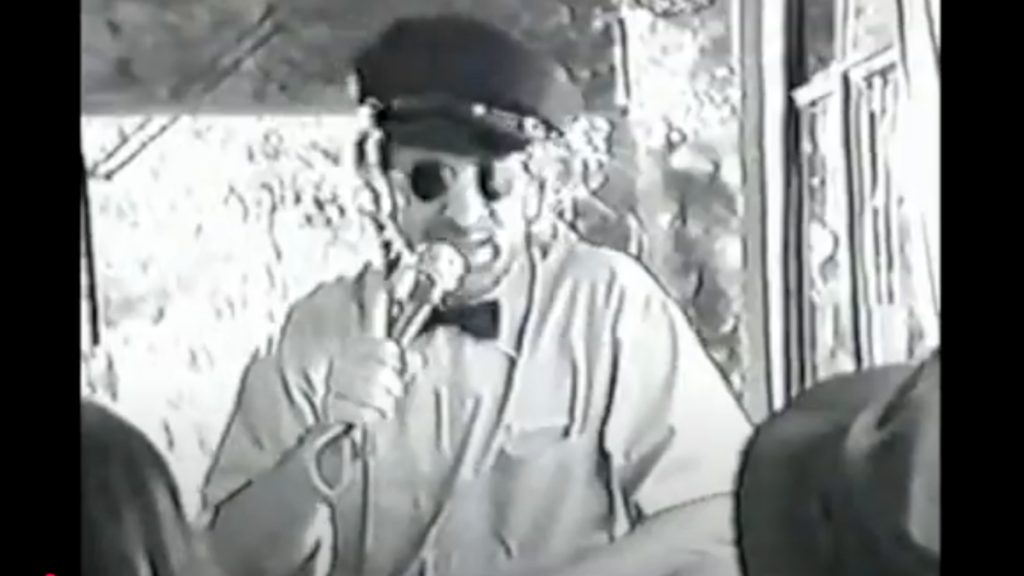
Mind you, as footage of this mechanical shark repeatedly coming up out of the water is shown, “Your Studio & You” ‘s off-screen narrator (who is voiced by Trey Parker says):
“But what about tomorrow? If we don’t keep in step with the times, things that were once neat and thrilling can become old and stupid.”
“Your Studio & You” Reception
This film was supposed to be shown only once at the welcoming party for Seagrams executive on the Universal Lot. And I’m told that – when Edgar Bronfman saw the finished product at that party – he reportedly turned to David Zucker and said “ … That’s a little more mean-spirited that I think it needed to be.”
And with that, “Your Studio & You” was supposed to go back into the Universal vault, never to be seen again. But when “South Park” debuted on Comedy Central in August of 1997 and then became a sensation for its biting humor, there was suddenly a lot of interest in what else Matt & Trey had done. Which is why copies of “The Spirit of Christmas” began to circulate. And – over time – copies of “Your Studio & You” began to bubble up.
Which – as Stone & Parker have repeatedly pointed out – was just not supposed to happen. Largely because none of the celebrities who appeared in “Your Studio & You” had never signed releases for Universal’s legal department. Because – again – this was for a movie that was only going to be shown once at a private function on the Universal Lot.
Matt mentioned (as part of a career retrospective at the Paley Center in LA back in 2000) that “ … they wouldn’t even let us keep a copy of the finished film.”
It’s a funny but brutal movie. And worth taking a look at today especially if you’re a theme park history buff because it shows Universal Studios Hollywood’s “Jurassic Park: The Ride” still under construction on the Lower Lot. That attraction would finally open to the public in June of 1996.
“Your Studio & You” became a lot easier to see after Seagrams sold off its share of Universal to Vivendi in 2000. Copies began propagating online after that. Though Universal Legal will periodically make an effort to get the latest copy of “Your Studio & You” taken off the Internet because – again – none of the performers who appear on camera ever signed the proper releases and/or were paid for their efforts.
That said, if you’re up for a mean-spirited laugh, “Your Studio & You” is well worth 14 minutes of your time. That said, once you watch this thing, be warned:
- You’re immediately going to be thirsty for a Seagram’s wine cooler
- And you’re going to have a sudden desire to go out & buy a porcelain deer.
-

 Theme Parks & Themed Entertainment7 months ago
Theme Parks & Themed Entertainment7 months agoDisney’s Forgotten Halloween Event: The Original Little Monsters on Main Street
-

 Theme Parks & Themed Entertainment8 months ago
Theme Parks & Themed Entertainment8 months agoThe Story of Mickey’s Not-So-Scary Halloween Party: From One Night to a Halloween Family Tradition
-

 Film & Movies8 months ago
Film & Movies8 months agoHow “An American Tail” Led to Disney’s “Hocus Pocus”
-

 Theme Parks & Themed Entertainment6 months ago
Theme Parks & Themed Entertainment6 months agoDisney and Macy’s 90-Year Thanksgiving Day Parade Partnership: From Mickey’s First Balloon to Minnie’s Big Debut
-

 Television & Shows4 months ago
Television & Shows4 months agoHow the Creators of South Park Tricked A-List Celebrities to Roast Universal – “Your Studio & You”
-

 History3 months ago
History3 months agoThe Super Bowl & Disney: The Untold Story Behind ‘I’m Going to Disneyland!’
-

 Podcast4 weeks ago
Podcast4 weeks agoEpic Universal Podcast – Aztec Dancers, Mariachis, Tequila, and Ceremonial Sacrifices?! (Ep. 45)
-

 Television & Shows1 week ago
Television & Shows1 week agoThe Untold Story of Super Soap Weekend at Disney-MGM Studios: How Daytime TV Took Over the Parks






